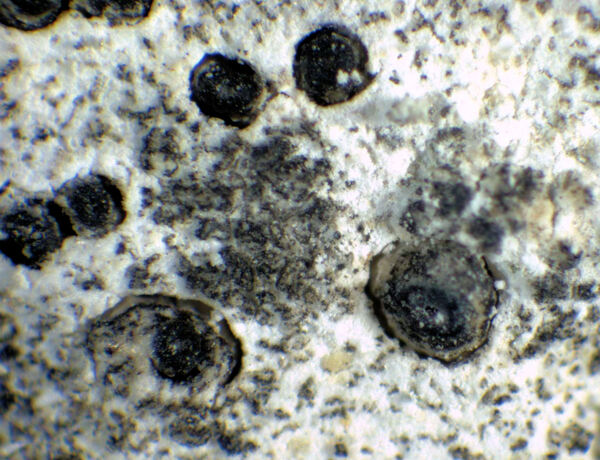Staurothele orbicularis (A. Massal.) Th. Fr.
Öfvers. K. Svensk. Vetensk.-Akad. Förh., 21: 275, 1865. Basionym: Porphyriospora orbicularis A. Massal. - Ric. Auton. Lich. Crost.: 154, 1852.
Synonyms: Porphyriospora orbicularis var. geographica A. Massal.; Staurothele nigella (Kremp.) Kernst.; Staurothele viperae Servít
Distribution: N - Ven (Lazzarin 2000b), TAA, Lig (Giordani & al. 2016). C - Marc (Nimis & Tretiach 1999), Umb (Genovesi & Ravera 2001, Ravera & al. 2006), Abr (Cucchi & al. 2009, Gheza & al. 2021).
Description: Thallus crustose, endosubstratic or thinly episubstratic and appearing as minute, dirty whitish grey flecks with numerous black, curved lines which are most numerous in the peripheral parts. Perithecia black, without involucrellum, 0.3-0.4 mm across, at first completely immersed, later forming conical-hemispherical projections with a flattened apex, often covered with a thalline layer at least at the base. Exciple dark throughout; hymenium I+ blue; hymenial algae more or less isodiametrical; hamathecium of periphyses and periphysoids, interascal filaments absent. Asci 2-spored, clavate, the wall thickened above, with an ocular chamber, after dehiscence with a delicate extruded endotunica, I-, K/I-. Ascospores (sub-)muriform, pale brown to orange-brown, oblong-ellipsoid to narrowly oblong, 35-60 x 12-20 μm. Photobiont chlorococcoid, present in both thallus and hymenium. Spot tests: K-, C-, KC-, P-, UV-. Chemistry: without lichen substances.Note: on more or less calciferous rocks in upland areas: related to S. guestphalica, but with 2-spored asci, and more widespread.
Growth form: Crustose endolithic
Substrata: rocks
Photobiont: green algae other than Trentepohlia
Reproductive strategy: mainly sexual
Commonnes-rarity: (info)
Alpine belt: absent
Subalpine belt: rare
Oromediterranean belt: absent
Montane belt: very rare
Submediterranean belt: absent
Padanian area: absent
Humid submediterranean belt: absent
Humid mediterranean belt: absent
Dry mediterranean belt: absent

Predictive model
Herbarium samples
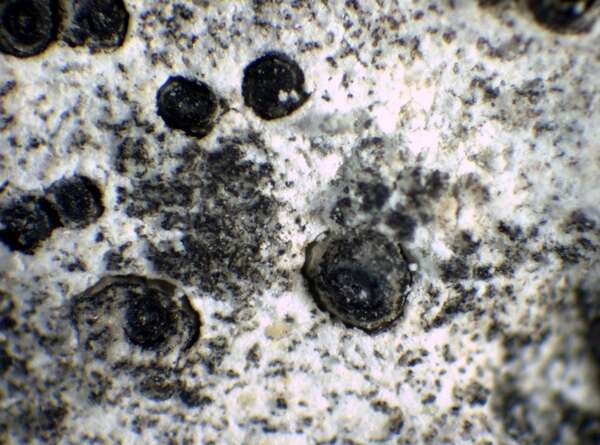

P.L. Nimis; Owner: Department of Life Sciences, University of Trieste
Herbarium: TSB (23366)
2001/11/30
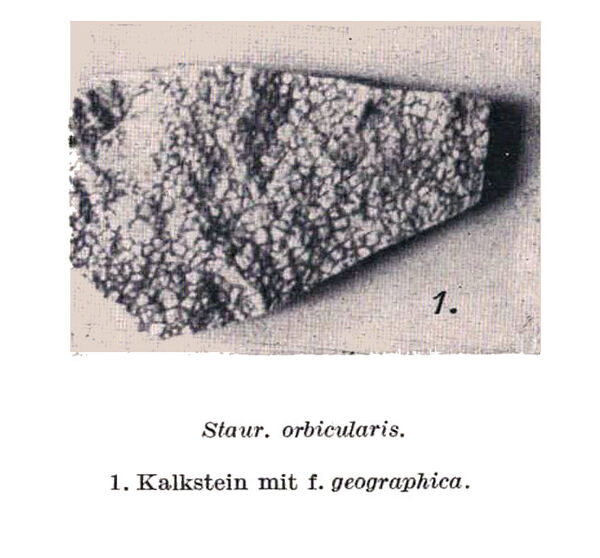
Zschacke, H. (1934) Epigloeaceae, Verrucariaceae und Dermatocarpaceae. In: Dr. L. Rabenhorst‘s Kryptogamen-Flora, Band 9, Abt. 1, Teil 1. Akademische Verlagsgesellschaft, Leipzig, 695 pp. - Public Domain
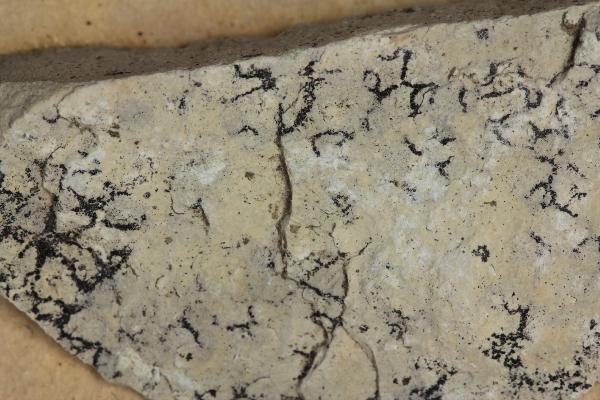
Collezione lichenologica Abramo Massalongo del Museo di Storia Naturale G. Ligabue di Venezia - Autori: Seggi, Linda; Trabucco, Raffaella Proprietà: Fondazione Musei Civici di Venezia - CC BY-NC
Italy, Veneto, in op. [Tregnago]
Porphyriospora orbicularis Massal. (gli sporidii sono color di porpora quando sono pefettamente maturi. Questo colore non osservasi in verun altro lichene fino ad ora conosciuto. L.
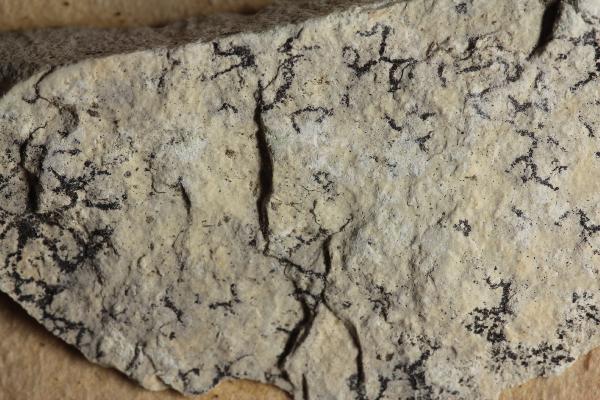
Collezione lichenologica Abramo Massalongo del Museo di Storia Naturale G. Ligabue di Venezia - Autori: Seggi, Linda; Trabucco, Raffaella Proprietà: Fondazione Musei Civici di Venezia - CC BY-NC
Italy, Veneto, in op. [Tregnago]
Porphyriospora orbicularis Massal. (gli sporidii sono color di porpora quando sono pefettamente maturi. Questo colore non osservasi in verun altro lichene fino ad ora conosciuto. L.
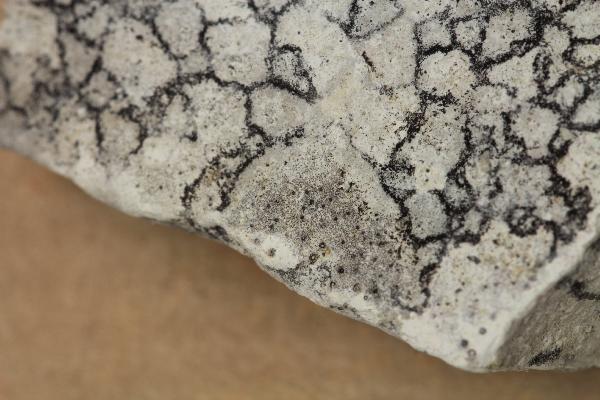
Collezione lichenologica Abramo Massalongo del Museo di Storia Naturale G. Ligabue di Venezia - Autori: Seggi, Linda; Trabucco, Raffaella Proprietà: Fondazione Musei Civici di Venezia - CC BY-NC
Italy, Veneto, in op. [Tregnago]
as Porphyriospora orbicularis geographica
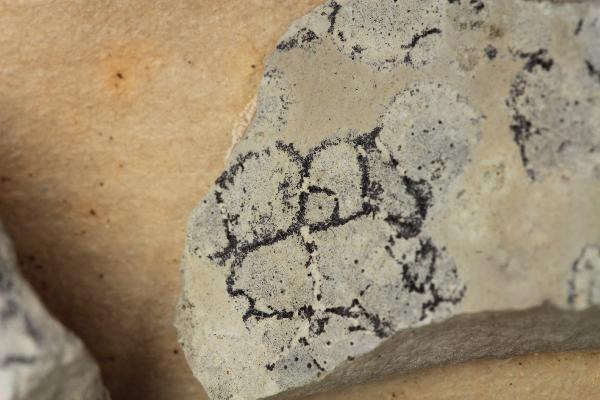
Collezione lichenologica Abramo Massalongo del Museo di Storia Naturale G. Ligabue di Venezia - Autori: Seggi, Linda; Trabucco, Raffaella Proprietà: Fondazione Musei Civici di Venezia - CC BY-NC
Italy, Veneto, in op. [Tregnago]
as Porphyriospora orbicularis geographica
Growth form: Crustose endolithic
Substrata: rocks
Photobiont: green algae other than Trentepohlia
Reproductive strategy: mainly sexual
Commonnes-rarity: (info)
Alpine belt: absent
Subalpine belt: rare
Oromediterranean belt: absent
Montane belt: very rare
Submediterranean belt: absent
Padanian area: absent
Humid submediterranean belt: absent
Humid mediterranean belt: absent
Dry mediterranean belt: absent

Predictive model
| Herbarium samples |


P.L. Nimis; Owner: Department of Life Sciences, University of Trieste
Herbarium: TSB (23366)
2001/11/30

Zschacke, H. (1934) Epigloeaceae, Verrucariaceae und Dermatocarpaceae. In: Dr. L. Rabenhorst‘s Kryptogamen-Flora, Band 9, Abt. 1, Teil 1. Akademische Verlagsgesellschaft, Leipzig, 695 pp. - Public Domain

Collezione lichenologica Abramo Massalongo del Museo di Storia Naturale G. Ligabue di Venezia - Autori: Seggi, Linda; Trabucco, Raffaella Proprietà: Fondazione Musei Civici di Venezia - CC BY-NC
Italy, Veneto, in op. [Tregnago]
Porphyriospora orbicularis Massal. (gli sporidii sono color di porpora quando sono pefettamente maturi. Questo colore non osservasi in verun altro lichene fino ad ora conosciuto. L.

Collezione lichenologica Abramo Massalongo del Museo di Storia Naturale G. Ligabue di Venezia - Autori: Seggi, Linda; Trabucco, Raffaella Proprietà: Fondazione Musei Civici di Venezia - CC BY-NC
Italy, Veneto, in op. [Tregnago]
Porphyriospora orbicularis Massal. (gli sporidii sono color di porpora quando sono pefettamente maturi. Questo colore non osservasi in verun altro lichene fino ad ora conosciuto. L.

Collezione lichenologica Abramo Massalongo del Museo di Storia Naturale G. Ligabue di Venezia - Autori: Seggi, Linda; Trabucco, Raffaella Proprietà: Fondazione Musei Civici di Venezia - CC BY-NC
Italy, Veneto, in op. [Tregnago]
as Porphyriospora orbicularis geographica

 INDEX FUNGORUM
INDEX FUNGORUM
 GBIF
GBIF
 DOLICHENS
DOLICHENS
